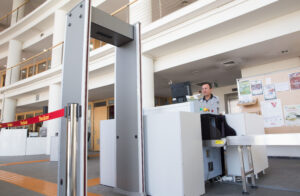In the dynamic world of business, the adoption of efficient Access Control Systems (ACS) is paramount. A well-implemented ACS not only fortifies security measures but also streamlines operations, ensuring that only authorized personnel have access to sensitive areas. With an array of options available, selecting the appropriate system tailored to your specific needs becomes crucial. This article delves into essential considerations for businesses contemplating the integration of an ACS, using Polimek Electronics’ innovative solutions as exemplary models.
Understanding Different Types of Access Control Systems
Access Control Systems (ACS) are critical components of modern security strategies, designed to regulate who can or cannot enter certain areas within a business environment. These systems vary widely in complexity, functionality, and the technology they employ, catering to the diverse needs of businesses across sectors. Understanding the different types of ACS and their technological underpinnings is essential for making an informed decision that aligns with your security requirements. For instance, the PL03 model from Polimek Electronics showcases the versatility of ACS. Equipped with a 5-inch touchscreen, it supports dynamic face recognition, password, ID card, and fingerprint authentication, demonstrating the diversity of control mechanisms available.
What to Think About When Choosing a System
- Identify Which Areas Need Protection: Begin by conducting a thorough assessment of your facility to determine which areas are sensitive and require controlled access. This could include server rooms, inventory storage, research labs, or executive offices. Prioritize these areas based on their security needs and the value of the assets they contain.
- Look at Security Risks: Perform a risk assessment to identify potential security threats and vulnerabilities specific to your business or industry. Consider internal risks, such as disgruntled employees, as well as external threats like theft or espionage. Assess how an ACS can mitigate these risks by controlling access to critical areas.
- Understand How People Move Around: Analyzing the flow of people throughout your premises is crucial. This involves understanding peak times, the volume of traffic in different areas, and the need for quick yet secure access. Systems that cause bottlenecks might be unsuitable for high-traffic zones, so choose a solution that balances security with efficiency.
- Decide on Security Levels: Different areas within your business might require varying levels of security. For instance, general office areas may only need a basic level of access control, while areas containing sensitive information might require multi-factor authentication (MFA), such as a combination of a card swipe, PIN entry, and biometric verification. Polimek’s PL03 model, with its capacity for dynamic face recognition and fingerprint authentication, offers a versatile solution for areas needing stringent access control.
- Plan for the Future: Consider the scalability and flexibility of the ACS. As your business grows or your security needs change, your ACS should be able to adapt. This includes adding more access points, integrating with newer technologies, and scaling up to handle more users without compromising performance or security. The PL01 device by Polimek, with its IP65 rating, exemplifies adaptability, particularly for outdoor environments, highlighting the importance of selecting systems that complement and enhance existing security needs
- Follow the Law: Compliance with legal and regulatory requirements is non-negotiable. This includes data protection laws like the GDPR, which may affect how you manage and store access logs, or industry-specific regulations that dictate security standards. Ensure the system you choose can help you comply with these requirements.
- Think About the Users: Consider the ease of use for both administrators and end-users. Systems that are too complicated can lead to user frustration, reduced compliance, and potentially create security gaps. Features like multi-language support, intuitive interfaces, and straightforward management tools can enhance user experience. Polimek’s PL05 model, supporting up to 20 different languages and featuring a 4.3-inch screen for interactive use, is an excellent example of prioritizing user accessibility, ensuring a seamless interaction for diverse user demographics. Cost Considerations
- Consider Costs: Factor in the initial investment, ongoing maintenance, and potential upgrade costs. It’s important to align the system’s capabilities with your budget without compromising critical security needs. Consider the return on investment in terms of security improvements, operational efficiencies, and potential cost savings from preventing security breaches.
- Technical Support and Training: Evaluate the level of technical support and training the vendor offers. Good support can significantly reduce downtime in case of system failures, and proper training ensures that your staff can fully leverage the system’s capabilities. Polimek Electronics offers 24/7 technical support for its Access Control Systems, ensuring businesses receive immediate assistance for any issue, anytime.
Conclusion
The selection of the right Access Control System is a nuanced decision that has far-reaching implications for the security and efficiency of a business. By offering a range of products that cater to diverse security needs, the industry stands at the forefront of access control solutions. From compact designs to versatile and robust systems, businesses are equipped with the tools needed to secure their premises effectively. With the addition of advanced technologies for QR-code-based access, security industry companies like Polimek ensure that businesses can embrace the future of security technology with confidence.






